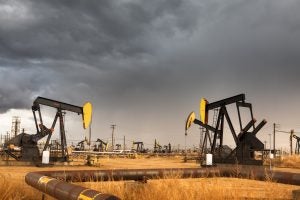As Permian drilling booms, will the Texas Railroad Commission stand against wasted gas?
 This piece originally appeared as an op-ed in the Midland Reporter-Telegram
This piece originally appeared as an op-ed in the Midland Reporter-Telegram
The West Texas Permian oilfield is poised for rapid development in the next decade; the Energy Information Administration projects oil production in the Permian could grow 60 percent by the year 2030. But oil wells in Texas’ Permian Basin don’t just pump oil, they also produce large amounts of natural gas – which many companies aren’t equipped to handle.
That is posing a problem for Texas, as producers run out of capacity to move associated gas to market. Without reasonable action from the state’s oil and gas regulator, the Texas Railroad Commission (RRC), producers could resort to simply burning away excess gas – something we’ve seen in other oil fields where gas is not the primary production target.
This process, also known as flaring, is a recipe for widespread waste and pollution.
When gas is flared, it releases harmful pollutants like particulate matter and sulfur dioxide. Simply allowing it to leak into the atmosphere is equally problematic. Natural gas contains methane, which is a potent greenhouse gas. It also contains toxic compounds like benzene, which can cause cancer, and volatile organic compounds, which are linked to respiratory illnesses. Seven counties in Texas’ Permian Basin rank in the top 10 nationwide for childhood asthma attacks.
This isn’t Texas’ first brush with excessive flaring. In 2011, companies in the Eagle Ford oilfield in South Texas burned 11 percent of all the gas produced, and in some counties more than 30 percent. This troubling history creates significant doubt that the Railroad Commission is poised to get ahead of the growing problem in the Permian Basin.
Recent history in the Permian is also cause for concern. An EDF report showed that during the last upswing in oil production, Permian operators in Texas flared 45.5 billion cubic feet of natural gas in 2015 alone. That’s enough natural gas to serve all of the household needs in Texas Permian counties for two and a half years. Flaring is also negatively impacting night time visibility at the University of Texas McDonald Observatory, located in the nearby Davis Mountains. The observatory is located in one of the darkest spots in the U.S. As Permian production creeps closer and closer, those dark skies are under threat along with the world-class science the observatory conducts.
Wasting gas is bad for Texas
Texas is both the nation’s largest producer and consumer of natural gas. We convert more natural gas to electricity than any other state in the country, and nearly one-third of Texas households rely on natural gas as their primary fuel source.
Natural gas, which burns cleaner than coal, has played a role (along with renewables and energy efficiency) in displacing dirtier and higher carbon-intensity coal plants. And yet some oil companies are likely poised to essentially throw this energy away.
The desire to pump additional oil in the short-term should not outweigh the value of Texans’, or the planet’s, long-term health and wellbeing. The RRC needs to make sure that during this next boom, industry receives a strong signal that it’s not ok to hang its wash on someone else’s line.
Texas can reduce flaring, but will it?
The good news is there is historical precedent for the RRC to regulate flaring. During the 1940’s, excessive flaring in Texas was rampant, and the Commission took forceful action to stop it.
The question today is: with an oil boom in full swing, will RRC use its authority to conserve Texas’ natural gas resources and minimize pollution – or sacrifice long term responsible energy development in favor of short term economic gains?
The state’s current general flaring rule (Rule 32) gives RRC the authority to prevent unnecessary waste, and with minor changes, would give the Commission any additional authority it needs to address this onslaught of wasteful flaring. The Commission also has rules specifically addressing the management of associated gas with authority to curtail or “pro-ration” production. The Commission should begin an immediate review of their existing regulatory authority for flaring and associated gas management (Rules 32, 45, 86, for example), and develop recommended strategies to prevent this unnecessary waste and pollution.
It should be noted some Permian operators are doing a good job of avoiding wasteful flaring. According to flaring data submitted to the RRC, more than one-third of the 15 largest operators generated consistent, minimal flaring rates — indicating there are existing tools and strategies that can effectively reduce flaring. At the same time, other producers are now counting on the RRC to give them a free pass to waste and pollute in order to keep the oil spigot flowing. Companies that have planned and invested to minimize their flaring and comply with existing RRC rules, would effectively be punished for responsible planning. The RRC has the tools they need to minimize flaring in the Permian, whether they have the political will remains to be seen.
[Tweet “As Permian drilling booms, will the Texas Railroad Commission stand against wasted gas?”]
Image via EDF’s report on natural gas flaring in the Permian Basin.










